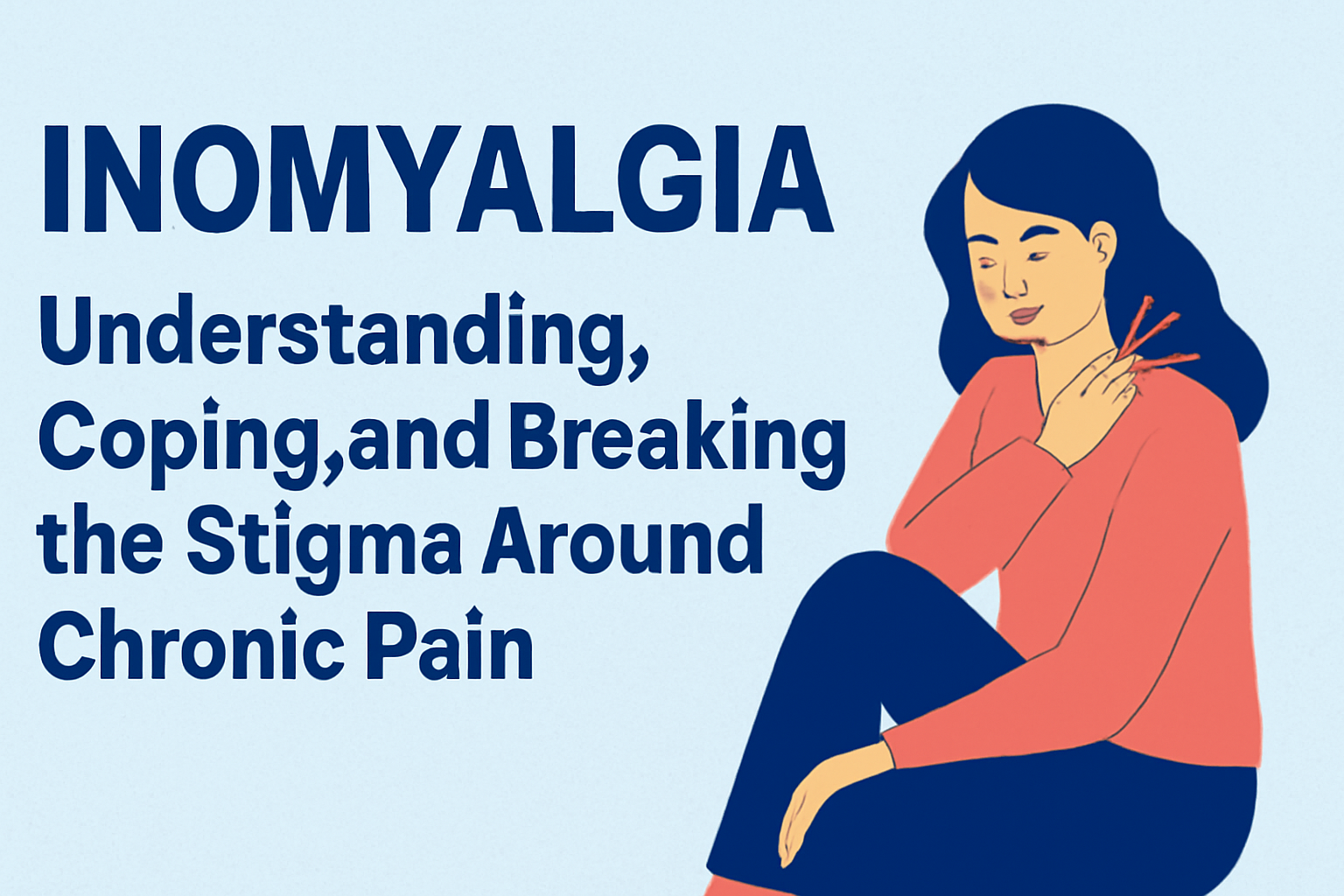
Inomyalgia
Introduction to Inomyalgia: What You Need to Know
Inomyalgia is a term that many people may not be familiar with, but it represents an important and often misunderstood condition. It’s a chronic pain disorder that affects millions of people, and it can have a significant impact on one’s daily life.
This article aims to break down inomyalgia in a simple, easy-to-understand way. Whether you’re someone who’s living with it or you’re trying to understand it better for a loved one, we will provide you with all the information you need.
The journey of dealing with inomyalgia can often be confusing, and the stigma surrounding chronic pain conditions can make things even more challenging. This condition isn’t just about physical discomfort—it affects emotional well-being and mental health, too. In this article, we’ll explore what inomyalgia is, its symptoms, treatment options, and how to cope with it in the best way possible.
What is Inomyalgia?
Inomyalgia is a chronic pain disorder that involves widespread pain in the muscles and soft tissues throughout the body. Unlike common aches and pains that can be attributed to injury or overexertion, inomyalgia doesn’t have a clear cause and can persist for months or even years. The pain is often described as a deep, aching sensation that can vary in intensity, and it can be accompanied by other symptoms such as fatigue, sleep disturbances, and cognitive difficulties (often referred to as “fibro fog”).
Although the exact cause of inomyalgia is not fully understood, researchers believe that it may be linked to an abnormal response in the way the brain and nervous system process pain. This means that even normal sensations of touch or pressure can be perceived as painful in individuals with inomyalgia.
The Symptoms of Inomyalgia
The symptoms of inomyalgia can vary from person to person, but some of the most common include:
Widespread Pain
The hallmark symptom of inomyalgia is widespread muscle and soft tissue pain. This pain may affect different parts of the body, including the neck, back, arms, and legs. The pain may be constant or come and go, and it can range from mild discomfort to severe pain.
Fatigue and Sleep Problems
People with inomyalgia often experience chronic fatigue, which can be debilitating. This fatigue is not simply feeling tired; it’s a persistent sense of exhaustion that doesn’t improve with rest. Sleep disturbances are also common, as individuals may find it difficult to fall asleep or stay asleep throughout the night.
Cognitive Issues (Fibro Fog)
Inomyalgia can also affect cognitive function, leading to what’s commonly referred to as “fibro fog.” This term describes the mental cloudiness that can make it difficult to focus, remember things, and concentrate.
Headaches and Migraines
Many people with inomyalgia experience frequent headaches, including migraines, which can add to the overall discomfort and make it harder to manage the condition.
Sensitivity to Touch and Temperature
Individuals with inomyalgia may also develop heightened sensitivity to touch, pressure, or temperature. This means that things that wouldn’t normally cause discomfort, like a light touch on the skin or a change in temperature, can be painful.
The Causes and Risk Factors of Inomyalgia
The exact cause of inomyalgia remains unclear, but there are several factors that might contribute to its development. Some of these include:
Genetics
Some research suggests that there may be a genetic component to inomyalgia. If someone in your family has this condition, you may be more likely to develop it as well.
Stress and Trauma
Emotional and physical stress can trigger or exacerbate inomyalgia. People who have experienced traumatic events, whether physical or emotional, may be more prone to developing chronic pain conditions like inomyalgia.
Sleep Disturbances
Poor sleep patterns are often seen in individuals with inomyalgia, and inadequate rest can contribute to the severity of symptoms. A lack of restorative sleep can also trigger increased sensitivity to pain.
Hormonal Imbalances
There is evidence that hormonal imbalances, particularly involving stress hormones like cortisol, may play a role in the development of inomyalgia. Women are also more likely to develop the condition, which suggests that hormones could influence its onset.
Diagnosing Inomyalgia: Challenges and Solutions
Diagnosing inomyalgia can be difficult because there are no specific tests that can definitively confirm the condition. Doctors often rely on a combination of patient history, physical exams, and ruling out other potential causes of the symptoms. Some of the key diagnostic criteria for inomyalgia include:
- Widespread pain lasting for at least three months
- Pain in multiple areas of the body
- No other underlying medical conditions that could explain the pain
Because of the challenges in diagnosing inomyalgia, it’s important for patients to find a healthcare provider who is knowledgeable about chronic pain conditions. A comprehensive approach that involves both medical treatment and lifestyle adjustments is often necessary.

Treatment Options for Inomyalgia: Managing Pain and Improving Quality of Life
While there is no cure for inomyalgia, there are various treatment options that can help manage symptoms and improve quality of life. These include both medical treatments and alternative therapies.
Medications
- Pain Relievers: Over-the-counter pain medications like ibuprofen or acetaminophen can help manage mild to moderate pain. For more severe pain, prescription medications, including muscle relaxants and anti-depressants, may be recommended.
- Antidepressants: Some types of antidepressants, such as selective serotonin and norepinephrine reuptake inhibitors (SNRIs), are used to help manage pain and improve sleep.
- Anticonvulsants: Certain anticonvulsant drugs have been shown to be effective in reducing nerve-related pain, which can be beneficial for people with inomyalgia.
Physical Therapy
Physical therapy can play a critical role in managing inomyalgia symptoms. A physical therapist can help patients develop a personalized exercise program that targets muscle strength and flexibility. Low-impact exercises such as swimming, walking, and yoga can improve mobility and reduce pain.
Cognitive Behavioral Therapy (CBT)
CBT is a type of talk therapy that can help individuals with inomyalgia manage the emotional and mental health aspects of their condition. CBT can help reduce the impact of stress, anxiety, and depression, which can exacerbate chronic pain.
Alternative Therapies
In addition to traditional medical treatments, many people with inomyalgia find relief through alternative therapies such as acupuncture, massage therapy, and chiropractic care. These therapies may help reduce muscle tension, alleviate pain, and improve overall well-being.
Coping with Inomyalgia: Practical Tips for Everyday Life
Living with inomyalgia can be challenging, but there are several ways to make daily life more manageable.
Pacing Yourself
One of the key strategies for managing chronic pain is pacing yourself. This involves balancing activity and rest throughout the day. It’s important to recognize your limitations and avoid overexertion, which can worsen symptoms.
Creating a Support System
Having a strong support system is essential when dealing with chronic pain. Whether it’s family, friends, or online support groups, having people who understand and support your journey can make a big difference.
Practicing Mindfulness and Relaxation
Mindfulness and relaxation techniques, such as deep breathing, meditation, and progressive muscle relaxation, can help reduce stress and manage pain. Regular practice can help improve mental clarity and promote emotional well-being.
Breaking the Stigma Around Chronic Pain Conditions
One of the biggest challenges of living with inomyalgia is the stigma surrounding chronic pain conditions. Many people may not understand the invisible nature of chronic pain, leading to feelings of isolation or frustration.
It’s important to advocate for yourself, educate others, and seek out supportive communities. Breaking the stigma around chronic pain can help create a more empathetic and understanding environment for everyone affected by inomyalgia.
Conclusion: Embracing Healing and Resilience
Inomyalgia is a complex and often misunderstood condition, but with the right approach, it is possible to manage symptoms and live a fulfilling life. Through a combination of medical treatments, lifestyle adjustments, and emotional support, individuals can regain control and break free from the limitations of chronic pain. By raising awareness and breaking the stigma, we can create a more supportive world for those living with inomyalgia.
If you or a loved one are struggling with inomyalgia, don’t hesitate to reach out to a healthcare provider for guidance and support. The road to healing may be challenging, but with the right tools and mindset, it is possible to live a life that is not defined by pain.
Call to Action:
If you’re ready to take the next step toward managing inomyalgia and improving your quality of life, start by consulting a healthcare professional who specializes in chronic pain. Together, you can create a personalized treatment plan that fits your needs and goals. Don’t let chronic pain control your life—take charge and embrace healing today!





